No fewer than four major art fairs have opened this week in New York, raising the curtain on more than 300 presentations taking place across Chelsea and Midtown Manhattan. Future Fair, NADA, 1-54, Frieze, and newcomer Esther are all open through this weekend.
While each art fair is attempting to carve its own niche in a crowded and competitive period for the New York art world (auctions, openings, and other events are also vying for collectors’ attention), they share an intention to surface relevant and emerging artistic talent in a location that galleries themselves recently voted the most important art fair city in the world.
Here, Artsy’s editorial team shares the artist discoveries that made an impression across Future Fair, NADA, 1-54, Frieze, and Esther.
Kaveri Raina
B. 1990, New Delhi. Lives and works in New York.
Showing at Frieze New York with Casey Kaplan
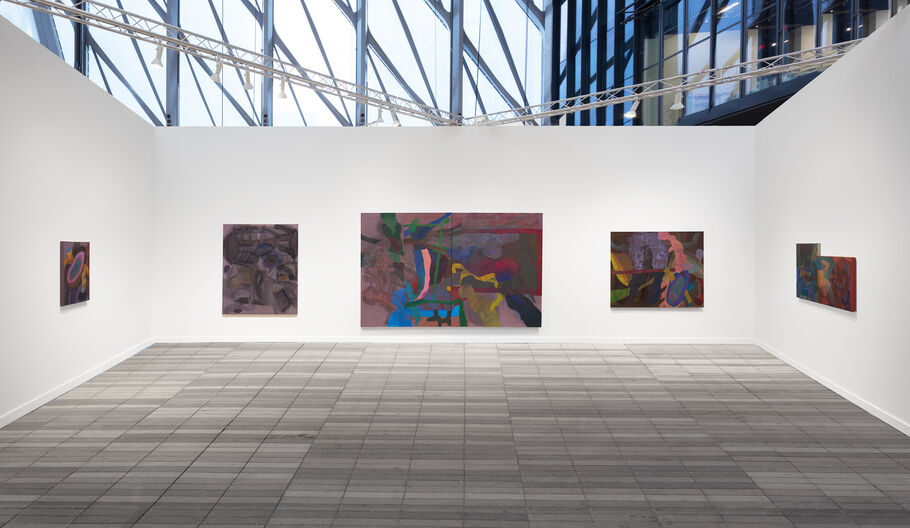
Installation view of Kaveri Raina’s solo presentation with Casey Kaplan at Frieze New York, 2024, booth B12. Photo by Sebastiano Pellion. Courtesy of the artist and Casey Kaplan
While discoveries are more common in Frieze’s Focus section (dedicated solo presentations by emerging galleries), on the ground floor of the fair, I was delighted to encounter the paintings of Kaveri Raina at Casey Kaplan’s booth. The solo presentation is a strong introduction to the artist ahead of her debut solo show with the New York gallery this November.
Made from acrylic, graphite, and oil pastel, the works feel both soft and visceral, filled with muted mauves, browns, and reds, yet punctuated by occasional flashes of bold colors, like cerulean or violet. Though they seem abstract at first, further inspection reveals landscapes and lingering bodies, which bear the weight and history of India’s colonial past. Each piece, filled with a fervor of world-building, is a sort of chapter of the artist’s unfurling story, populated by a cast of recurring characters.
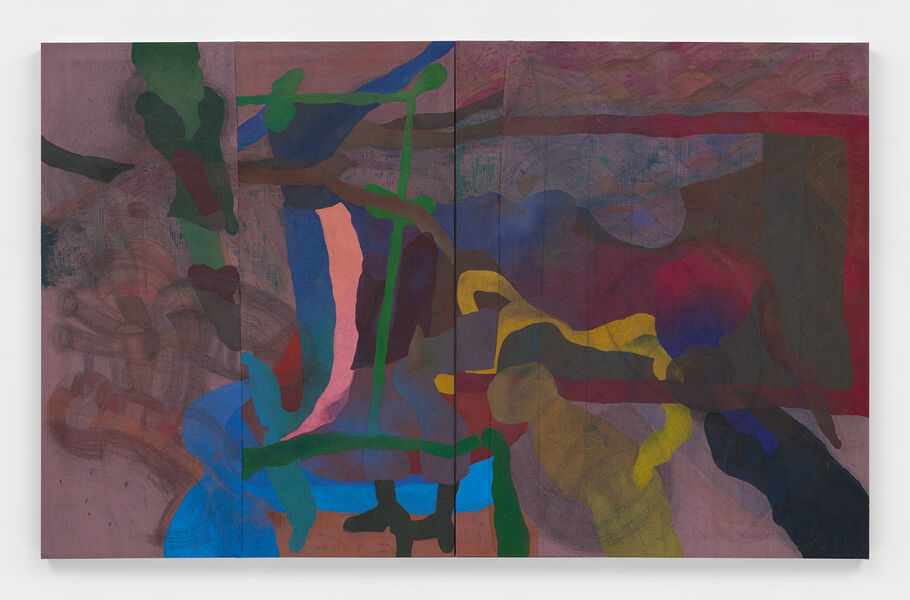
Kaveri Raina, the kingdom, the cave, the beginning, and the sun shining through the haystacks, 2024. Photo by Dan Bradica Studio. © Kaveri Raina. Courtesy of the artist and Casey Kaplan, New York.
“We were initially taken with Raina’s bold and densely layered forms on burlap that draw from the women protagonists of India’s colonial and recent histories,” said gallery director Veronica Levitt. “Through this lens, fragmented bodies reveal themselves amid swirls of graphite and oil pastel, giving shape to Raina’s contemporary voice within a complex narrative.”
Raina’s work was featured in a solo show last year at Chicago’s PATRON, and in a group show with Toronto’s Cooper Cole in January.
—Casey Lesser
Emma Safir
B. 1990, New York. Lives and works in New York.
Showing at NADA New York with HESSE FLATOW and Blade Study

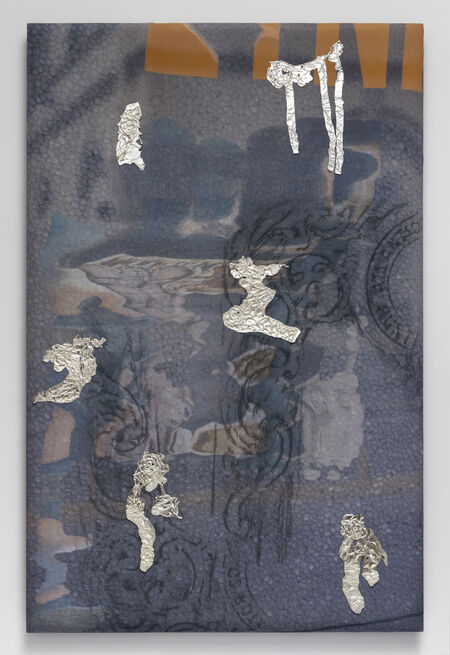
Emma Safir, POSIE, 2024. Photo by Jenny Gorman. Courtesy of the artist and HESSE FLATOW, New York.
Emma Safir, Cheval Glass, 2024. Photo by Jenny Gorman. Courtesy of the artist and HESSE FLATOW, New York.
To be fair, I knew of Emma Safir’s work prior to this week, so I would say this was more of a re-discovery (she was featured in our “Artists on Our Radar” series in October 2021). That said, the New York–based Yale grad’s works felt more compelling than ever and were featured prominently at NADA—on the ground floor in an impressive solo booth with the young Lower East Side gallery Blade Study, and upstairs within a three-artist presentation with Chelsea’s HESSE FLATOW.
In both presentations, we see the fresh ways that Safir is continuing to grow her practice, deftly employing both digital and analog techniques. The works serve as both partitions and portals, and push us to consider ideas of privacy. The wall-based pieces continue Safir’s practice of stitching together photographs digitally and then printing them on silk and using upholstery techniques to conjure supremely elegant paintings.
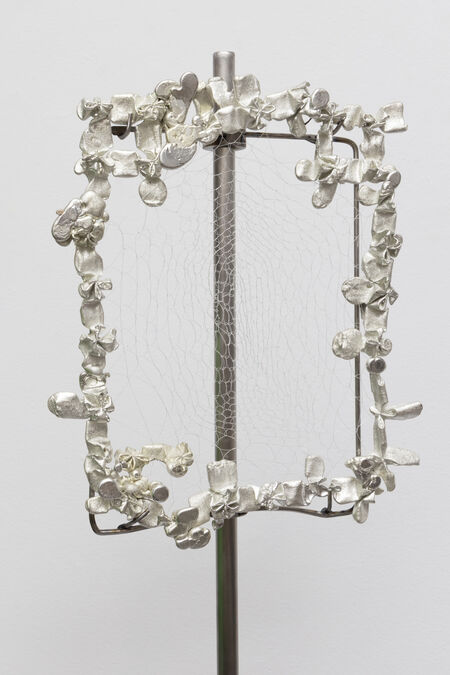
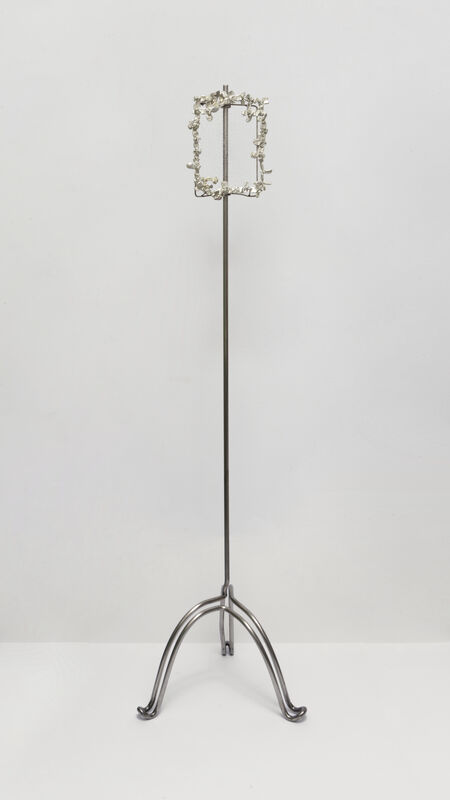
Emma Safir, detail of SHEILD (Pole Screen I), 2024. Photo by Jenny Gorman. Courtesy of the artist and HESSE FLATOW, New York.
Emma Safir, SHEILD (Pole Screen I), 2024. Photo by Jenny Gorman. Courtesy of the artist and HESSE FLATOW, New York.
Notable, too, is Safir’s use of silvery pewter, which adorns the paintings with shimmery blossoms or lacelike flourishes, though there are standalone sculptures, too. Particularly exciting are the tall metal stands topped with frames filled with delicate webs that reinvigorate the tradition of 18th-century face screens.
Safir opened a solo show with Blade Study this week and will have a solo exhibition with Selena Parnon Project Space in New York later this year.
—C.L.
Ugonna Hosten
B. 1982, Nigeria. Lives and works in Kent, England.
Showing at 1:54 with Ed Cross Fine Art
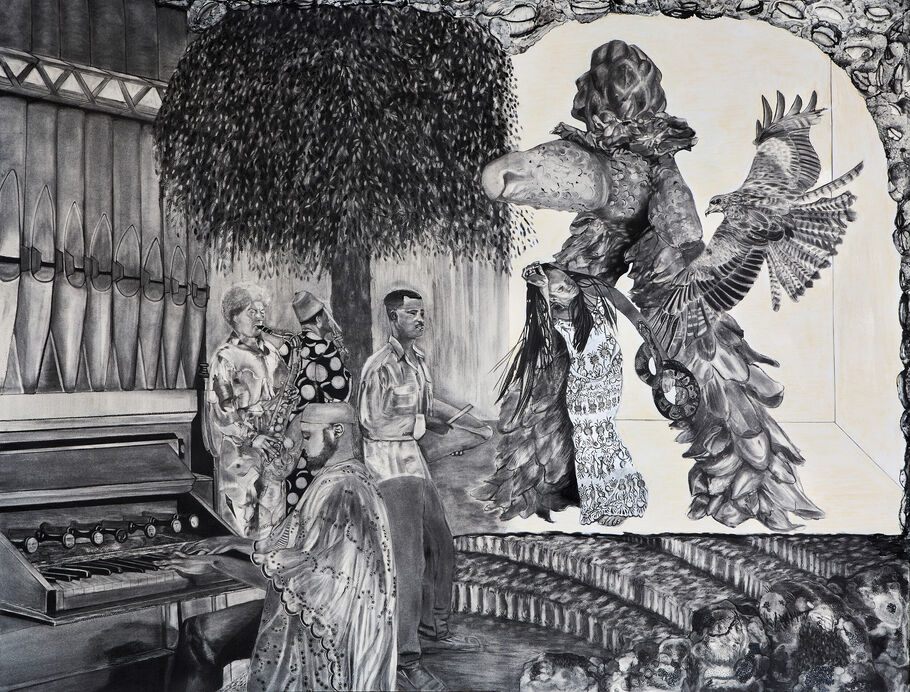
I was gripped by the depth and narrative profundity of a series of works on paper by Ugonna Hosten, on view at London gallery Ed Cross Fine Art at 1-54. The Nigerian British artist explores spirituality, mythologies, and pre-colonial histories in these monochromatic works, which I returned to several times as I browsed the fair.
Hosten’s works are the result of direct memories from her dreams—which often include family members—and the artist’s intensive research into pre-colonial Igbo spiritual practices. She creates intricate scenes that are both cinematic and fantastical, bringing in elements from spiritual practices such as cowrie shells, which, according to the artist, “symbolize the dark, unknowable depths and act as psychic conductors in seeking wisdom in those depths.”
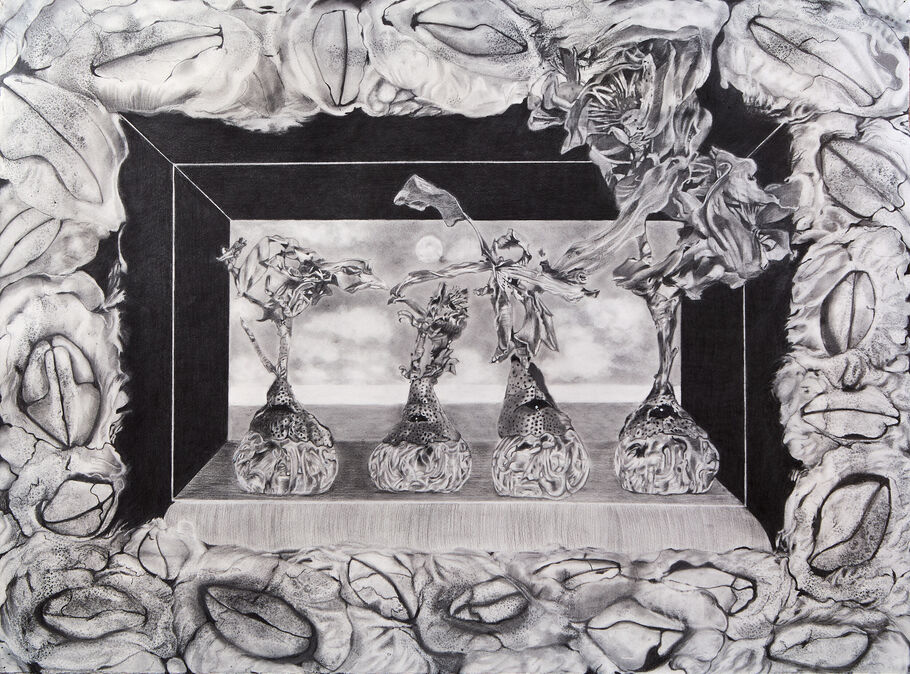
It’s a testament to Ugonna’s compositional skill that all of these strands come together with a deft coherence. In The fluency of Isato (2024), for example, a man playing the organ is accompanied by a trio of musicians, while a woman holding a snake appears to dance nearby. Here, the mythological, historical, personal, and imagined come together in emotive harmony.
Ugonna is a self-taught artist, and last year had a solo show at York Art Gallery in York, England. The booth presentation—which is shared with Nigerian artist Abdulrazaq Awofeso—marks the first time that Ugonna’s work has been shown in the U.S. and, according to Cross, was being met with considerable interest from fair visitors.
—Arun Kakar
Elizabeth King Stanton
Lives and works in New Bedord, Massachusetts.
Showing at Future Fair with Abigail Ogilvy Gallery
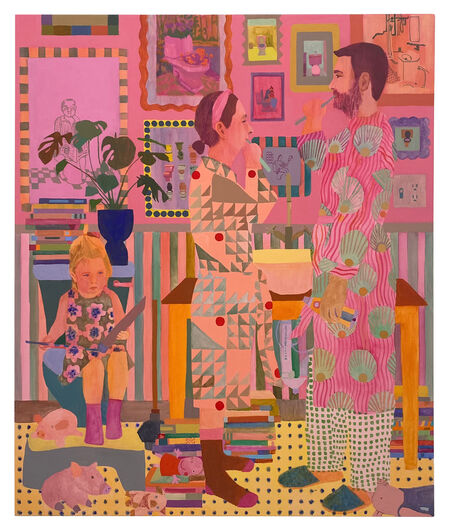
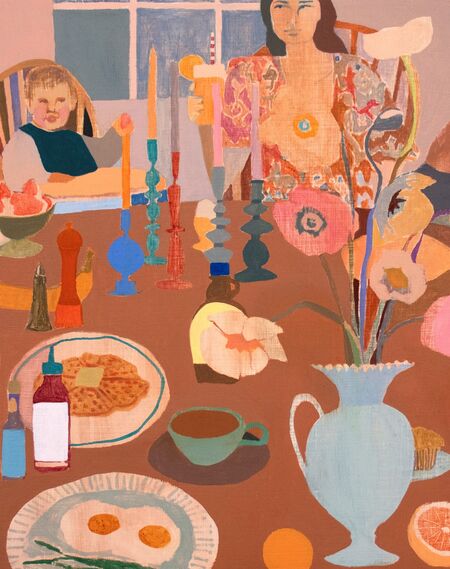
The “newness of motherhood” informs the paintings of Elizabeth King Stanton, which depict moments spent with her young daughter, and are rendered with tenderness and formal inventiveness that caught my eye at Abigail Ogilvy Gallery’s Future Fair booth. I was drawn to King Stanton’s use of blocky, tonal colors, which are patterned into and around the domestic environments and everyday scenes that she represents.
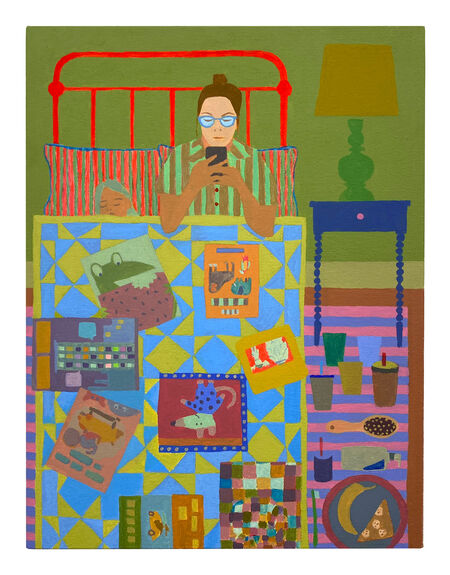
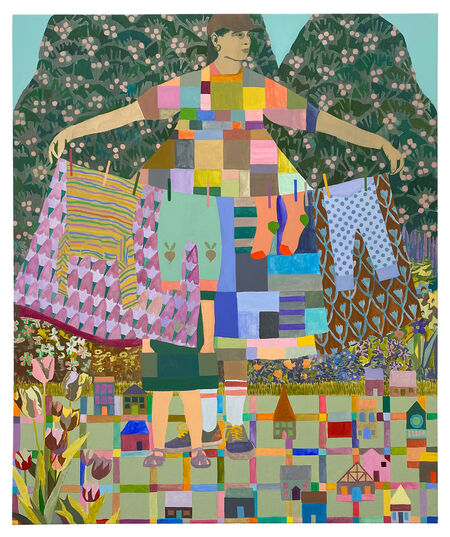
In Hide + Seek (2024), for example, the artist’s daughter is shown embedded in the laundry being hung on a clothesline by her mother; and in 7.26 PM (2024), the pair are together in bed, the mother on her phone while the daughter lies cozily next to her, an array of children’s books and cups scattered around them. “It’s that moment when she’s waiting for her daughter to fall asleep and you have to sneak out of the bedroom,” said gallery founder Abigail Ogilvy of the work, which was among my favorites at the fair, not least because of a touching reference to Maisy the Mouse—a childhood favorite of mine.
The booth marks the first time that King Stanton’s work is on view in New York, and the artist has previously appeared in group presentations at the likes of Saatchi Gallery in London and the New Bedford Art Museum.
—A.K.
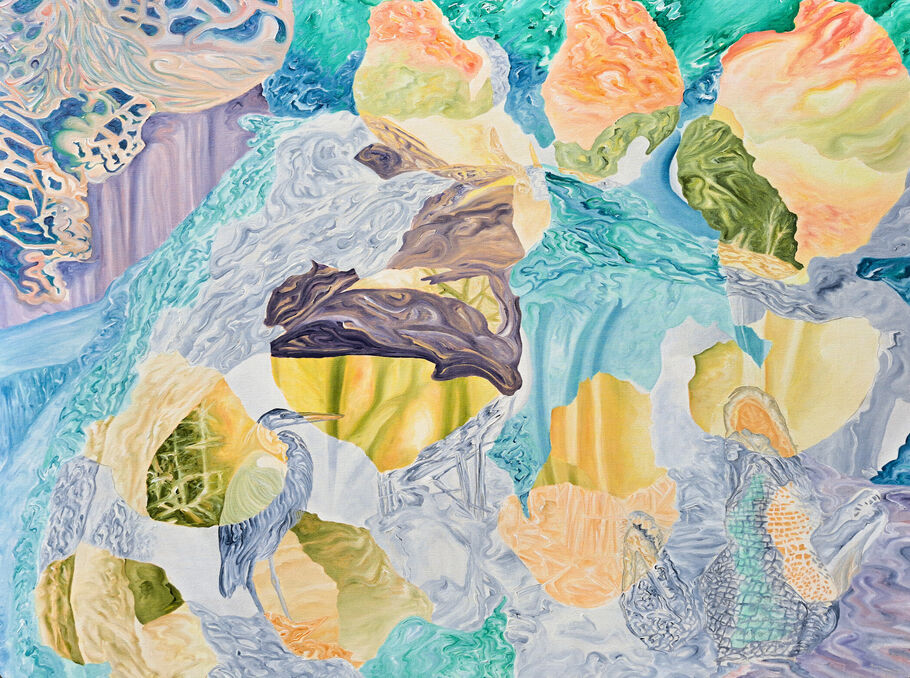
I had to double-take when I encountered the paintings of Mexican Ghanaian artist Kwadwo A. Asiedu at Nigerian gallery kó’s 1-54 booth because I thought that his abstract landscapes were moving. Perhaps that sensation had more to do with my lingering jet lag, but these works—of which there are two at the booth—do contain a powerful symbiosis that feels as though they are trapped in motion.
Asiedu is a trained photographer and his works are informed by an archive of images, which he turns into digital collages and then paints from. The result is textured layers of color that examine the natural world, in this case through aquatic and earthly components.
In Glisten by the Bayou (2023), a heron is among the constituents, standing majestically with lapping blues, oranges, and greens surrounding it. The work encapsulates the artist’s intention of bringing about new ways of seeing nature and how we interact with it.
A self-taught artist, Kwaido had his first solo show last year in London with Kristin Hjellegjerde Gallery and is set to have another solo with the gallery this year at its Berlin outpost.
—A.K.
Bertha Leonard
B. 1928, Atlantic City, New Jersey. Lives in Philadelphia.
Showing at Esther with Margot Samel
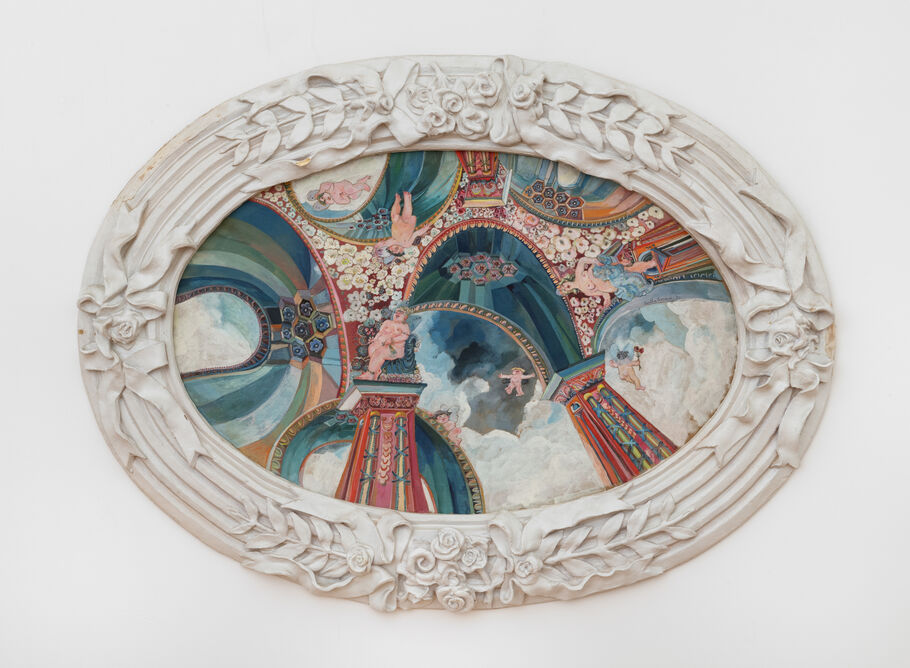
Bertha Leonard, Innocence, 1983. Courtesy of the artist and Margot Samel.
Bertha Leonard’s work is not just a new discovery for me, but also for New York gallerist Margot Samel. At Esther, the new alternative fair that Samel co-founded, she’s showing a pair of works by Leonard, having learned of the 96-year-old artist’s practice within the last two months. Leonard stopped painting in her seventies after her eyesight faltered, and Google could not tell me much about her practice. But the two works on view at Esther—with their stylized figures, explosive patterning, and Rococo sensibilities—offer a thrilling introduction.
Born in Atlantic City, New Jersey, Leonard gravitates to subjects including boardwalks, parades, and other seaside scenery. Other works lean into the fantastical: Innocence (1983), an ovoid oil-on-board painting meant to be mounted overhead, takes the perspective of an earthbound viewer looking up to see cherubs darting around a vaulted ceiling that opens up to the heavens.
Leonard’s work was recently included in “Fortitude at 50,” an anniversary exhibition at Gross McCleaf Gallery in Philadelphia, and is in the collection of the Pennsylvania Academy of Fine Arts.
—Olivia Horn
Angela Fang Zirbes
B. 2000, Iowa. Lives and works in New York and Iowa.
Showing at Future Fair with Hashimoto Contemporary
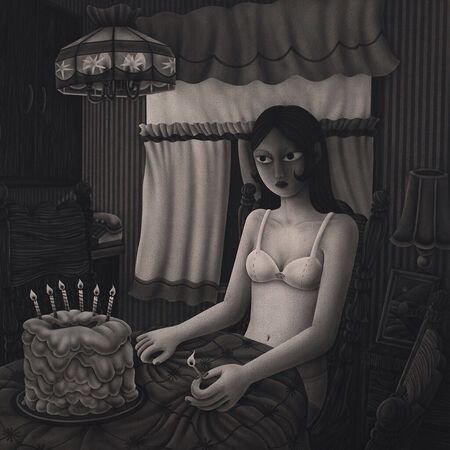
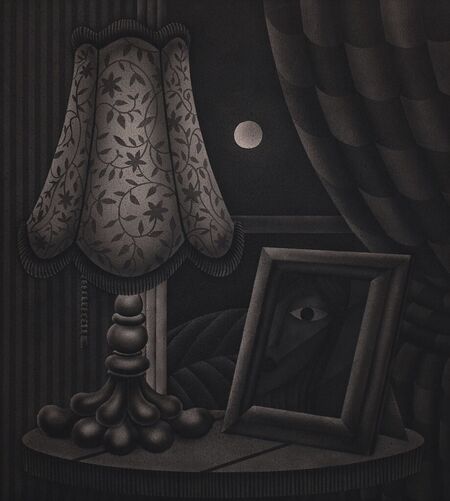
Splashy, buoyantly colored paintings are in no short supply at Future Fair, but my eye was drawn to Angela Fang Zirbes’s moody monochromes. Her airbrushed paintings of moonlit interiors have a velvety texture; a strange, somnambulant quality; and a recurring female protagonist who often seems to be caught on the cusp of destruction—holding a lit match, a pair of scissors, or a knife. These scenes, with their internal references and repeated motifs, engage in a captivating kind of storyboarding. For the artist, they are a means of revisiting her childhood and examining the alienation she’s experienced as a biracial person in the Midwest.
It turns out I’m not the only new fan of Zirbes: She was announced as the winner of Future Fair’s inaugural Artists Prize, an award that comes with a residency at Virreina Art Space in Santander, Colombia. The artist, who earned her BFA from Parsons School of Design in 2023, is being presented at the fair by Hashimoto Contemporary, which has previously included her in several group exhibitions. She has also shown with the New York gallery Harman Projects.
—O.H.
Norberto Spina
B. 1995, Turin, Italy. Lives and works in London.
Showing at NADA New York with Cooke Latham Gallery
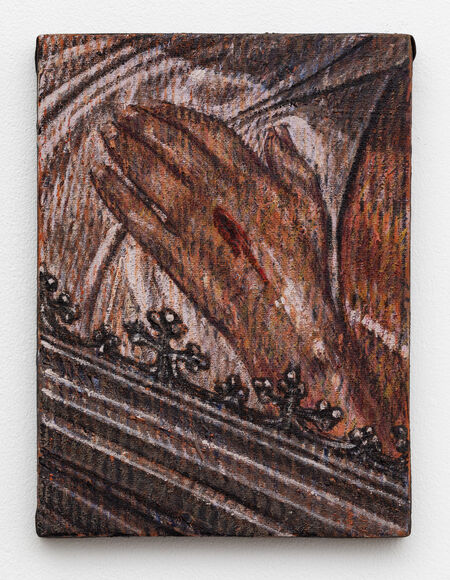
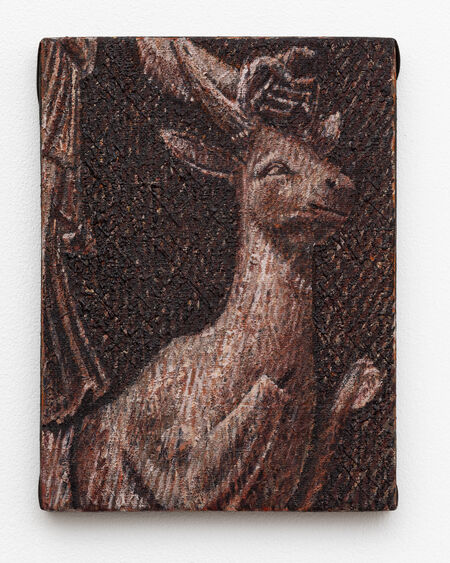
Alternating between a chthonian nightmare and an ethereal daze, Italian artist Norberto Spina’s “Arcadia” series at Cooke Latham Gallery’s booth stirred a morbid, spiritual curiosity in me. These works, measuring a mere 9.6 by 7.1 inches, are immersed in shadows, depicting close-ups of images such as a pig farm in Arcadia II or a hand holding a switchblade in Arcadia VI (both 2024).
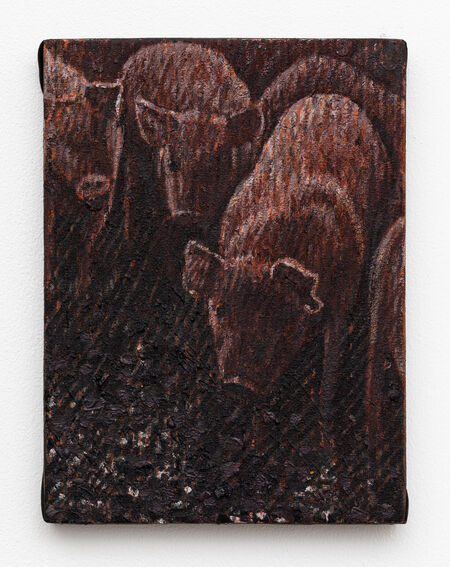
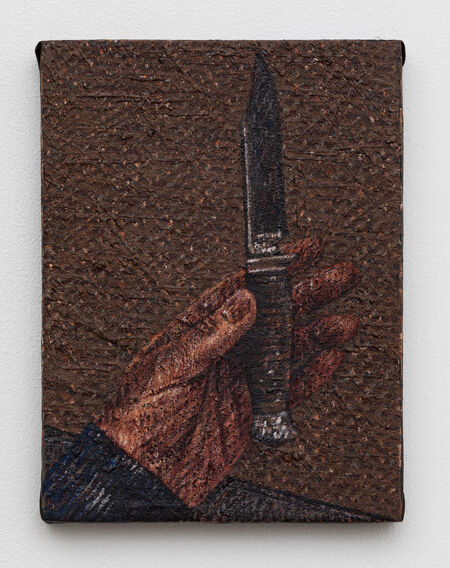
Spina sources the subjects of his paintings from archival images, old family photographs, scenes from his daily life, and iPhone photography, disrupted by symbols of religious Italian iconography. The clash between the contemporary and the historical parallels how contemporary life in Italy takes place among the historical. Spina creates these works by layering paint and marker pen, rendering these images with muted shadows.
Living and working in London, the 29-year-old artist is currently wrapping up his MFA at the Royal Academy. His installation at NADA is a revival of his 2023 “Arcadia” installation at the Royal Academy Schools, leaving me hoping to see a solo show of his in the near future. Recent group shows include “After Reminiscence” at Milan’s Cassina Project, and “Field of difference” at Palmer Gallery in London, both this year.
—Maxwell Rabb
Szabolcs Veres
B. 1983, Satu Mare, Romania. Lives and works in Cluj-Napoca, Romania.
Showing at NADA New York with Spencer Brownstone Gallery

Szabolcs Veres, Aria, 2024. Courtesy of the artist and Spencer Brownstone Gallery.
Close to the front entrance at NADA, Spencer Brownstone Gallery’s group presentation drew guests into its booth throughout the first day of the fair. As I walked up and down the four floors of 548 West to view the rest of the fair, I kept returning to see Szabolcs Veres’s Aria (2024). A headless portrait of a woman in a yellow dress on the edge of a bed, this expressionistic painting is rendered as if excerpted from a childhood memory, where everything in the background and foreground fades from the core image.
The painting is among three other small works by the Romanian artist. Born in 1983 in Satu Maru, the artist currently resides in Cluj-Napoca, where he earned his PhD, MFA, and BFA at the University of Art and Design. Veres has presented three solo shows at Spencer Brownstone Gallery in New York, including “The State of Mind” in 2023. Earlier this year, the gallery hosted another solo booth of the artist at Zona Maco in Mexico City.
—M.R.

